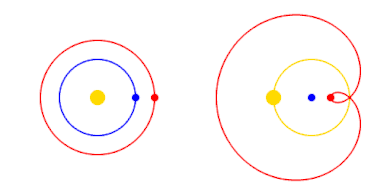
Back Koperniese Rewolusie Afrikaans ثورة كوبرنيكوس Arabic কপাৰনিকাচ বিপ্লৱ Assamese Revolució de Copèrnic Catalan Koperníkovský obrat Czech Kopernikanische Wende German Κοπερνίκεια επανάσταση (μεταφορά) Greek Revolución de Copérnico Spanish انقلاب کوپرنیکی Persian Révolution copernicienne French

For simplicity, Mars' period of revolution is depicted as 2 years instead of 1.88, and orbits are depicted as perfectly circular or epitrochoid.
The Copernican Revolution was the paradigm shift from the Ptolemaic model of the heavens, which described the cosmos as having Earth stationary at the center of the universe, to the heliocentric model with the Sun at the center of the Solar System. This revolution consisted of two phases; the first being extremely mathematical in nature and the second phase starting in 1610 with the publication of a pamphlet by Galileo.[1] Beginning with the 1543 publication of Nicolaus Copernicus’s De revolutionibus orbium coelestium, contributions to the “revolution” continued until finally ending with Isaac Newton’s work over a century later.
- ^ Gillies, Donald (2019-04-10), Why did the Copernican revolution take place in Europe rather than China?, retrieved 2019-12-03